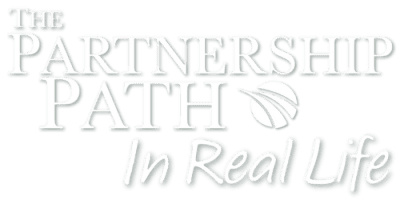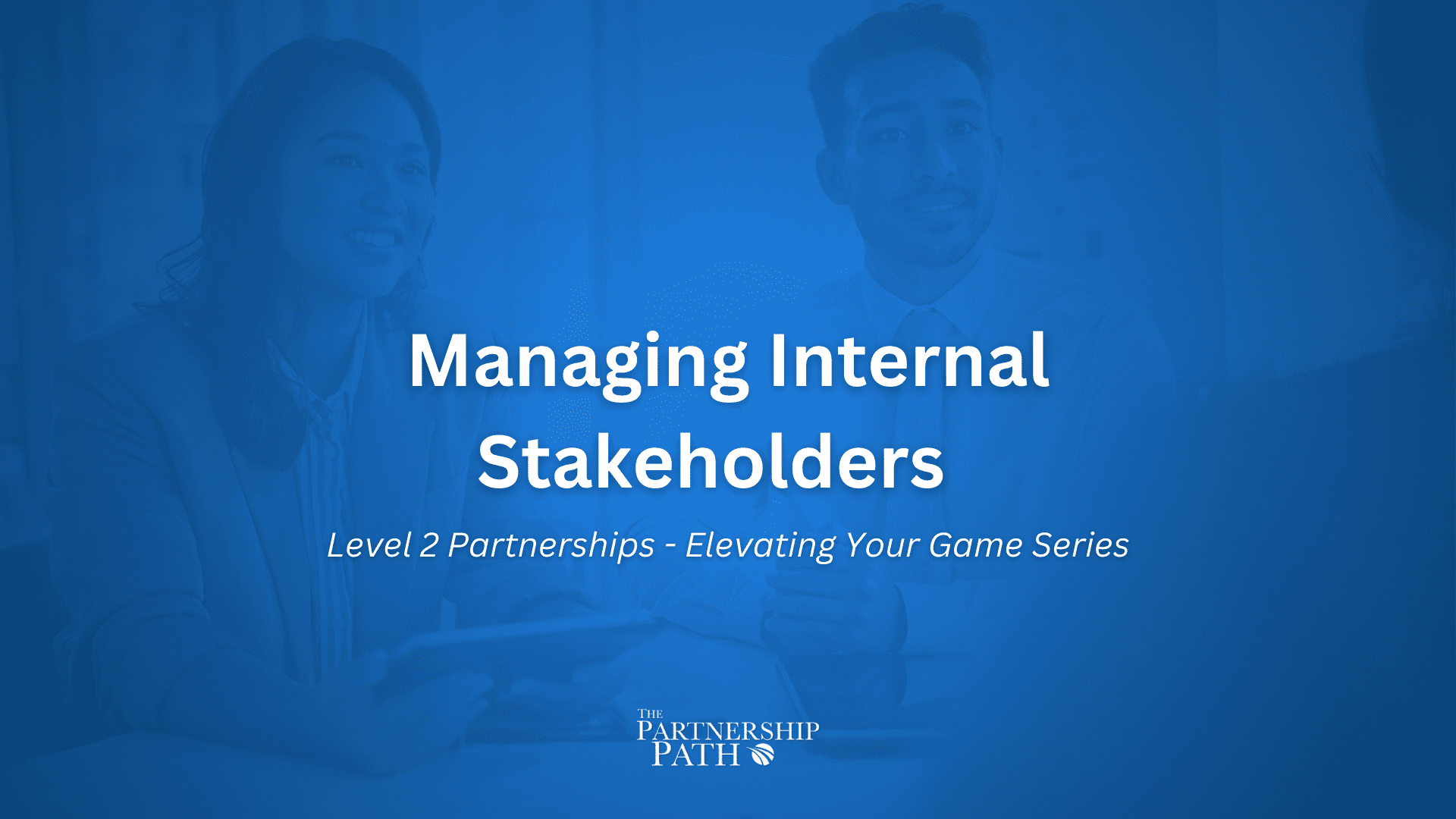Stephanie Vasiloff at Flywheel.io
On Preparing And Motivating Sales Teams
Episode Summary
In this episode of the Partnership Path in Real Life podcast, host John Rudow welcomes Stephanie Vasiloff, VP of Partnerships at Flywheel.io, medical imaging AI platform. They discuss best practices for preparing and motivating partnership sales teams, emphasizing the importance of understanding the “what’s in it for me” approach for both internal teams and partners.
Stephanie highlights the need for clear value propositions, the significance of solving problems for mutual customers, and building trust through early wins in partnerships. Their conversation underscores that successful partnerships require creativity, simplicity in communication, and a deep understanding of each party’s motivations and goals.
Transcript
John (00:03)
Well, hello, Stephanie, and welcome to the Partnership Path in Real Life podcast. I’m so excited to have you on an episode. I know we’ve been talking about doing this for a while, so I’m glad it’s finally come to fruition. Obviously, you and I know each other, but our audience may not know you. So let’s start with letting you introduce yourself to the audience. Tell us a little bit about what you do, where you work, and how long you’ve been working with partners.
Stephanie (00:15)
Yes.
Sure. Yeah, that sounds good. Thank you, John. And good to see you again. It has been a little while. So hi, everyone. Steph Vassiloff. And I am currently the VP of partnerships at a small medical imaging data and AI platform startup company. Try saying that three times fast. Very, very niche industry to be in. But I’ve been in the partner world for, gosh, about nine years, I want to say. I mean, John, that’s back when I met you. I was once upon a time at Microsoft.
and was in a bunch of different roles in and around partner, mostly on the ISV side for that time. So I have seen it all from the really big to now the very, very tiny components of what it takes to partner. And yeah, I’m looking forward to the conversation. So thanks for having me.
John (01:07)
Yeah.
Yeah, and I love that range of experience stuff. Having you on the show is so great just because as we talked in preparation for this about now that you’re working for this really small organization, trying to work with big organizations, you’ve had an opportunity to see things from a whole different perspective, which is just super cool for our audience to be able to know that there’s people out there who are in the same boat, right, that are struggling, that not everybody works for the massive Microsofts of the world. So, yeah.
Stephanie (01:38)
Anyway.
Hey, hey.
John (01:42)
So listen, having you on, we wanted to talk about preparing and motivating partnership sales teams. And Tony and I, as you know, you just listened to that. Tony and I did an episode on that, talking a little bit about kind of the best practice. And so this is about you coming on and telling us, how does it really work? So first off, let’s just start with, how did you respond to the episode that Tony and I did? What resonated for you there? What stood out?
Stephanie (01:51)
Yes.
So I think there are three things I just wanted to hone in on a little bit from the episode. So between yourself and Tony, I mean, overall, you guys definitely nailed it. There are a couple of things that I think are worth digging into a little. The first one was one of the comments that you had made, John, around the what’s in it for me. Definitely want to touch on that. And then the internal and external value prop piece. I think you guys covered it at a high level, but there’s one really specific thing that I think would be interesting to talk about a bit.
John (02:30)
Yeah.
Stephanie (02:41)
And then the third one is just Tony had mentioned like what problem can you solve for your partner? I want to briefly touch on that as well.
John (02:49)
Awesome, I love that. Wow, how prepared. I love that. All right, let’s jump in. So.
Stephanie (02:52)
I’ve got a little bit of passion around this. So yeah, the gosh, the what’s in it for me, that one to me is just so interesting because again, coming from, you know, the large Microsofty world now to a really small startup company, it is going to be so different depending on the partners that you’re working with. And it’s not just the partners what’s in it for me. It’s your own companies and your own sales team. So.
John (03:05)
Yeah.
Yeah, yeah.
Stephanie (03:17)
As you guys had alluded to, some will care about consumption. Some will care whether you’re Amazon, Google, Microsoft. Like, are you can you sell through my marketplace? Well, we can try. Some care about hardware. I mean, there are just so many things. So I think really the underlying theme there is as you are starting up a new partnership and specifically wanting to get to that COSEL relationship, it’s about currencies. Like at the end of the day, it is about currencies. And what does your own sales team care about? What does their sales team care about?
John (03:39)
Yeah. Right.
Stephanie (03:45)
and build a plan together that hits on both. And there are some cases where your own, your company, your solution may not speak to what they do care about. An example, we are working with a hardware company right now. They don’t care about consumption, which is sort of our bread and butter. So we’ve tried to get really creative to get their sales team to pay attention so that they are incented to actually care about us, work with us, et cetera. So that’s just such an important one as you’re getting that relationship moving.
John (04:02)
Right. Yeah.
Yeah, I mean, look, you’ve keyed in on one of the hardest things, I think, right? Because the example you gave, if it’s not super obvious that you both care about the same thing or you can find something to care about, that makes it really, really hard. And to your point of getting creative, I always think of that as a really nice way to say, you know, we’re having to work a lot harder to get people to do what we want them to do.
Stephanie (04:29)
It does.
John (04:41)
But it is possible. If you spend enough time at it, you can usually figure it out. There’s usually some way to do it. Yeah. Cool. All right.
Stephanie (04:46)
For sure. Yep. And I know we only have a few minutes, so I’m not going to go into all the examples, but.
John (04:52)
That’s okay. No, hey, bring it on. If we go long because it’s really valuable information, I’m happy to go long. So if you got a good example, throw it at everybody.
Stephanie (05:02)
Well, I think one, just one quick one, and you had actually briefly mentioned it was the like the SPF component. So in this particular hardware company situation, they just weren’t incentive. We weren’t retiring quota. They weren’t going to get paid on selling our solution. So we worked with their head of sales to inquire about whether or not we could actually create some sort of separate incentive. So they would get a few dollars out of it to keep them motivated to sell small example, not always easy to execute.
John (05:08)
Yeah.
Stephanie (05:29)
But that was a way to get us to start paying more attention or to get them pay more attention.
John (05:31)
Right. Totally. So I’m really glad we took the time for you to use that example, right? Because people need to hear that, that there are lots of different ways to motivate the teams on either side. And you got to try and figure out what that is and work until you get there. And even if it’s something that you’re like, well, it’s not great, but it’s better than nothing, that’s exactly what you need. All right. Let’s go to your second topic, the internal extra value proposition.
Stephanie (05:48)
Great.
for sure.
All right. And I think what we just covered really is aligned with that internal value prop, the what’s in it for my team, what’s in it for that team. And a lot of it is just understanding, like, what’s the overall value of the partnership? So in some cases where we are a small operation right now, we just want net new logos. We’re not necessarily looking to require or to retire quota with this specific partnership. We just need to get out there more in front of customers. So that’s what we care about. Where are some of our bigger partners? They want quota.
or they want marketplace sales. So it’s just sort of rounding out that internal value prop to my team, here’s why we are doing this, and then to that partner team. But I think the bigger piece there is the external value prop. And this is one where I think folks just get so tied up in their own worlds that they forget at the end of the day, this partnership, there should be a problem.
that you are solving for your customers and for your mutual customers. That is why you’re coming together. You’re putting your solutions together for this better together story. So I think number one is just knowing what is that? Why do our customers care that we have a partnership and that we are actually doing some sort of co -selling or co -innovation relationship? But then along those lines, if you want your partner team, well, I’ll rephrase.
John (06:58)
Yeah, that’s right.
Stephanie (07:18)
You should want your partner team to be able to be comfortable giving the level 100 version of what your pitch is. Here’s this partner I’m introducing. Here’s why we think they’re cool. Here’s why they’re important. And vice versa. I want my team to be prepared to do that on behalf of the partner as well. And I have seen, partners throw in like a 15 page pitch deck to say, well, here’s our value prop and here’s how to talk on product.
John (07:42)
Yeah. Yeah.
Stephanie (07:44)
your partner sales team, they are going to throw that away, ignore it, and there’s no way they’re going to take the time to look through that. So just simplicity here is so important. What is the one page better together story that gets your own sales team comfortable talking about the partner solutions and that gets them comfortable talking about yours? Because once there’s interest and you get beyond that, that’s when you bring each other’s teams in to really deep dive. But that just simple, simple key thing I’ve seen be amiss time and time again.
John (07:47)
That’s right.
That’s right.
Yeah. And, and look, I think that first topic and this topic are so intertwined as you say, right? Because if, if you struggle to get the right incentives in place and it’s maybe not the greatest incentive, it’s good enough, but it’s not great. But then you make it too hard for them to actually, you know, articulate your value prop. You’ve lost the game, right? So you got it. You got to hit on all, on all cylinders for that. So you got to.
Stephanie (08:18)
Yeah.
Yes.
John (08:40)
It’s got to be both motivating and easy for them to do it. You know, you were talking about, I wanted to dig in on that just a little bit. One of the things that I’ve always seen people struggle with is this differentiating the better together, right? Like each of the partners come to the table with a pretty good differentiation story to the customer as a standalone offering.
Stephanie (08:40)
for.
Yes, absolutely.
Mm -hmm.
Right.
John (09:09)
But how is my combination with you different than my combination with one of your competitors when we go to the customer? Like, talk a little bit about that.
Stephanie (09:19)
That that that is a really, that can be a really tough one, depending on the industry that you’re in. I will say when I was on the Microsoft side of things, that was always the question. And I don’t think I had enough empathy at the time with the partners I was working with to understand that that can be really difficult when there are similar solutions.
So this is going to be a very, I’ll say, generic response, but unfortunately, I think that is, you know, it’s just how it goes sometimes. It is just finding like whatever that little bit of magic is for that specific partner, because you could have very overlapping stories. So just find that one key, fun, interesting, like factoid or solution or thing to talk about. Just focus on to say this is that differentiator.
John (09:50)
Yep.
Stephanie (10:15)
Right now I have the luxury of being in a very, very niche market and industry segment where we just don’t have that problem because we are one of the only ones that catered towards our customers. So I’ll say that’s probably where I have a little less specific advice there, but it really is working with the partner to come together and just figure out that one thing that they don’t already talk about in regards to other partnerships.
John (10:45)
Well, I think, look, the fact that you don’t have like an easy answer for that, I think is actually news to not news, but it’s welcome to most of our listeners because sometimes I think we want there to be a silver bullet or some secret sauce. And the truth of the matter is, is there’s not, and it just takes hard work to, you know, really sit down and try and find that little thing, that one little thing, that little special thing or whatever that we can differentiate.
Stephanie (11:06)
Yes.
John (11:14)
And at the same time, still make it simple enough for people to remember. Yeah. Yeah. Cool. All right. Third, I’ve already forgotten what your third one was, but I know you know it.
Stephanie (11:18)
For sure, yes.
I do is well, one thing that Tony had mentioned that I just really liked and she had said fixing their one big issue when you’re trying to build that trust and build some momentum, it’s fixing that issue. And I would actually take that up a little bit of a level here and say that it’s not necessarily even the issue, but it’s that first proof point. It could be fixing an issue for them. In some cases, it could just be like, get that first win and show.
John (11:33)
Yeah.
Yeah.
Stephanie (11:52)
your own team and that partner team that, hey, we can do this and look what just happened. We solved it. And I think even setting expectations that getting to that first, that first win, that first problem solved, whatever it might be, is going to be the most difficult one as well. You’re working out the kinks, you’re figuring out the process, the storyline. But once that first one is done, you’ve got the proof point, you’ve got the customer story, you’ve got a way to iron out any of the kinks.
And that’s when like the flood gates open and you really start getting that engine running.
John (12:23)
Yeah, it’s another one of those. There is no magic to that. It’s about rolling up your sleeves and finding the problem first off. Like what is that thing that we can address together and then rolling up your sleeves and doing it. You may remember in, I know it was a long time ago when you sat through some of our training, but we talk about the trust factor, right? Between two individuals about trust. And we use David Maester’s formula of
Stephanie (12:38)
Absolutely.
John (12:52)
credibility plus reliability plus intimacy divided by self -orientation. And what you just described in terms of solving the problem is exactly that. I mean, that is a credibility builder. It’s a reliability builder. It’s an intimacy builder because you’re in it together. And most importantly, it’s their issue very often that you’re trying to solve, which is a self -orientation issue. And if you can build that trust, that helps you move forward.
Stephanie (12:55)
Yes.
Right.
John (13:21)
gets you that next thing, that next kind of go -to -market that you can do together or whatever. It opens up the doors for you to keep going.
Stephanie (13:32)
Absolutely. And gosh, the trust factor is such a big thing. And just listening, always listening. And I think we focus, even in this conversation, John, we focused so much, or I guess I focus so much on the sales side, because obviously that was the point of this episode. But you have to remember that it’s the entire end -to -end engagement. And it’s not just the pitch or the better together story.
It is the relationships, it’s making sure you can transact. It’s then the go -to -market. I mean, it’s that entire thing that you have to keep in mind as you’re putting these plans together and figuring out that whole better together storyline.
John (14:08)
Yeah, for sure. All right, Steph, so listen, we’re almost at time, so let’s do this. We have lots of people who listen who are sometimes new to partnering or maybe they’re an old partnering person, but in a really new situation. So when you think about preparing and motivating sales teams in a partnership, what’s your kind of advice to somebody who’s sitting there?
Stephanie (14:29)
and
John (14:36)
new to partnering, sitting with a new portfolio, knowing they’ve got to do this and they don’t know where to start. Like what’s your kind of, you know, not secret sauce, because we said there is no such thing, but you know, what’s your advice to them?
Stephanie (14:43)
Yeah, man.
It’s a great question. I would go back to the understanding currencies piece. It is not only knowing your own company’s value prop, what your team cares about, but it’s getting to know your partners, their industry, the problems they’re trying to solve, and again, what motivates them. I think if you start getting all of those pieces, you’ll get at least that base level of what the partnership should start from. So.
John (15:16)
I love that. And I know you well enough to know that embedded in that first step is to be transparent with your own motivators, right? To start the conversation with, hey, look, here’s what I’m trying to do. Here’s what my people care about. What do your people care about, right? Getting that currency conversation going starts with being super transparent and honest. Yeah. Stephanie, thanks so much for coming on the show. It’s so exciting to have you here. And,
Stephanie (15:19)
Thank you.
Absolutely.
Yes.
Absolutely. I’m glad you brought that up for sure.
John (15:46)
You’re so well prepared. I have to have you back on another one sometime soon. So when we find another topic Yeah. All right. Thanks Stephanie. Have a great day
Stephanie (15:51)
I would love to. Please. Yeah.
Thanks, John.
Key Takeaways
- Understanding Currencies: To effectively motivate sales teams in a partnership, it’s crucial to understand the “currencies” that matter to both your own team and your partners. This includes their specific needs, goals, and what drives their performance.
- Clear Value Proposition: Both internal and external value propositions must be simple and straightforward. Partners should be able to articulate the benefits of the partnership without getting bogged down in complex presentations. A concise, compelling narrative fosters better engagement.
- Building Trust Through Early Wins: Establishing trust is vital in partnerships. Achieving an initial success—whether solving a problem or securing a win—serves as proof of concept and strengthens the relationship, enabling further collaboration and joint efforts.



